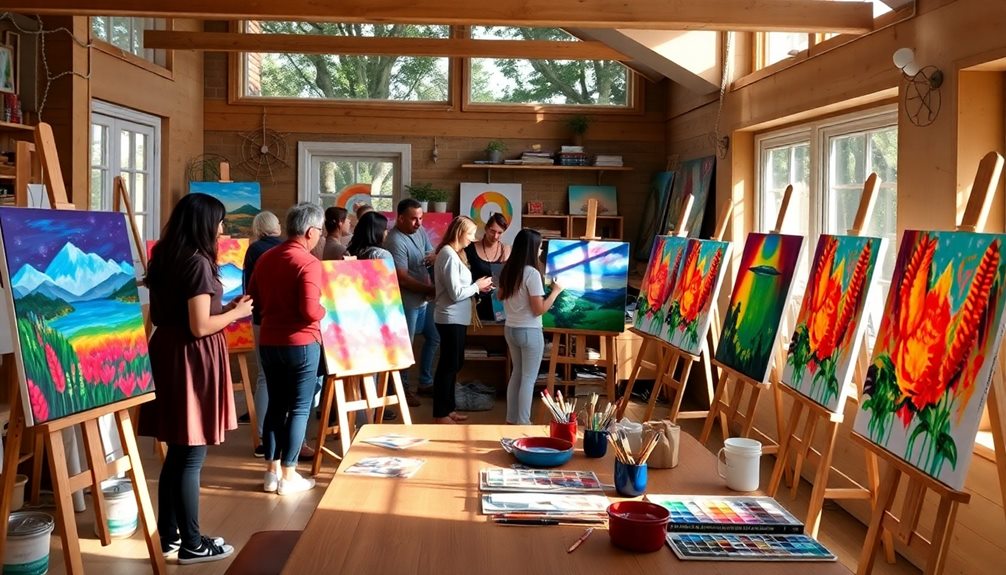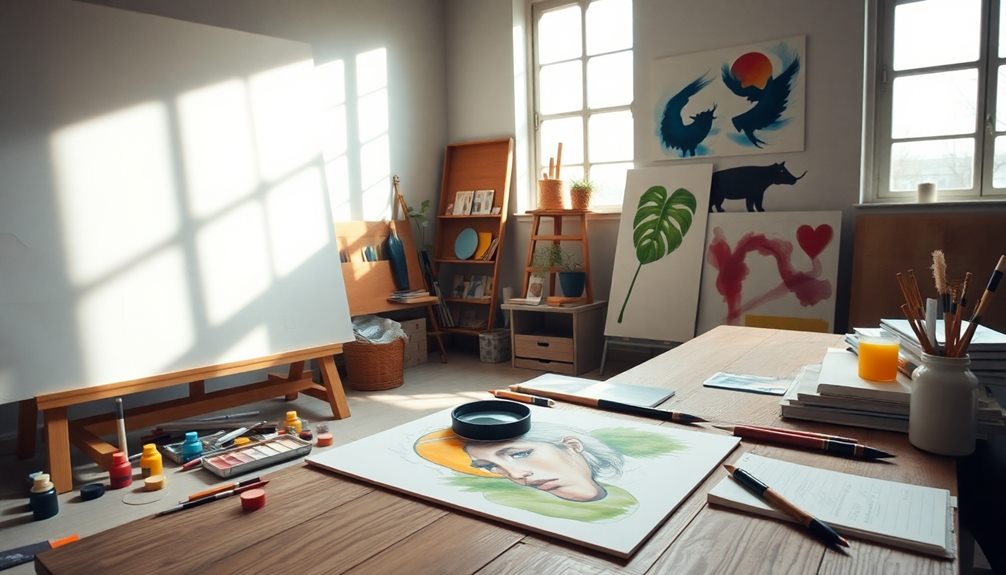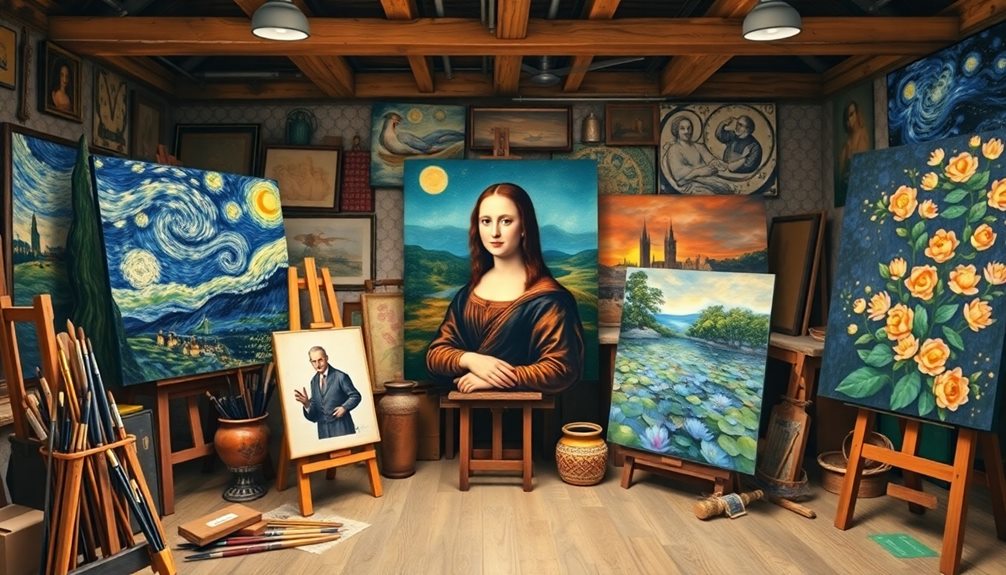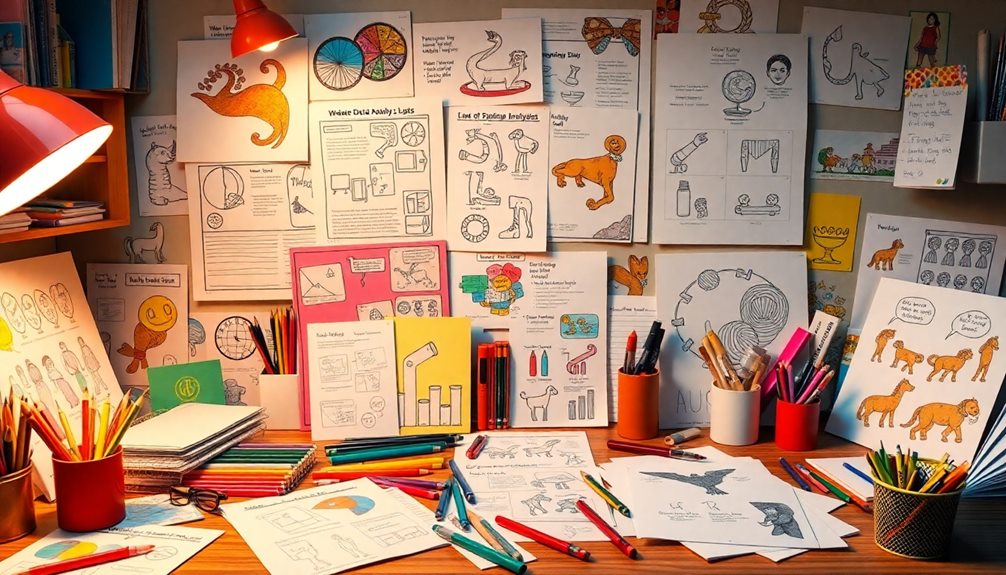Teaching art appreciation to beginners helps you connect with diverse cultures and histories. Start by exploring emotional connections to artworks; let your feelings guide you. Visit galleries and museums to experience art firsthand, and keep an art notebook to jot down your thoughts. Familiarize yourself with significant artists and movements, from the Renaissance to contemporary art. Engage in discussions with others to deepen your insights and critical thinking. Curiosity drives exploration, making art appreciation a lifelong journey. Keep your eyes open—there's much more you'll discover about how to cultivate a rich understanding of art!
Key Takeaways
- Encourage direct engagement by visiting galleries and museums to experience art firsthand, fostering a deeper connection and understanding.
- Utilize accessible resources like documentaries and books to build foundational knowledge about significant artists and art movements.
- Promote emotional growth through personal reflections and discussions about art, enhancing critical thinking and observational skills.
- Implement hands-on activities and collaborative projects to engage young learners and make art appreciation relatable and enjoyable.
- Foster curiosity by asking open-ended questions that stimulate exploration and discussion about artworks and their historical contexts.
Importance of Art Appreciation
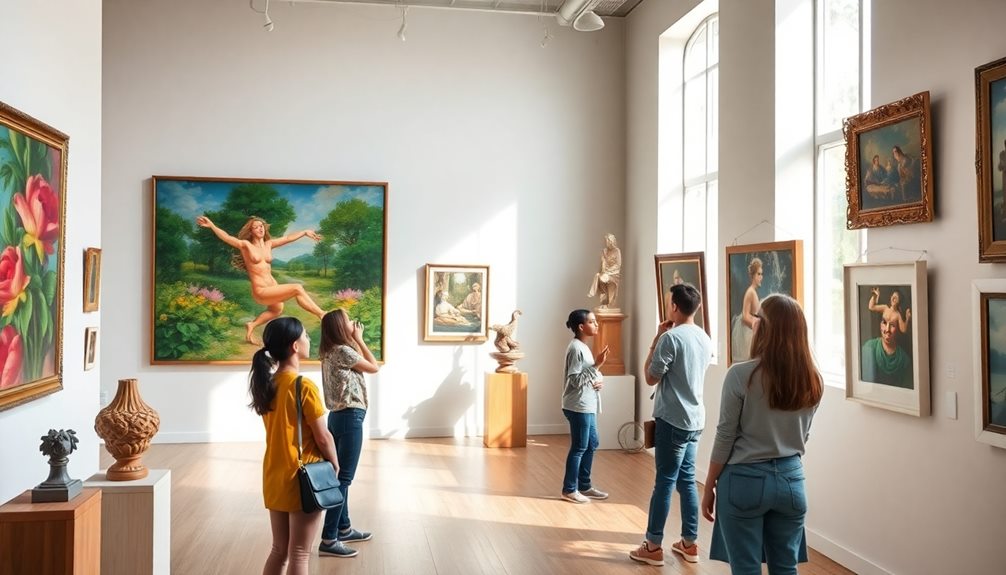
Art appreciation isn't just about admiring beautiful paintings; it's a gateway to understanding history and cultural heritage. When you immerse yourself in art, you connect with the narratives that shape societies and human experiences, which can be further enriched by engaging with the evolution of personal artistic style.
This connection not only enhances your understanding of different cultures but also enriches your perspective on the world.
Engaging with art sharpens your observational and critical thinking skills. You learn to analyze and interpret visual information, equipping you with tools that extend beyond the art classroom. In fact, studies show that participation in art education often correlates with improved academic performance across other subjects, highlighting the intertwined nature of creativity and learning.
Moreover, art appreciation nurtures emotional intelligence. It encourages you to express feelings and thoughts about artworks, fostering personal growth and social development. As you explore diverse art forms, you cultivate a well-rounded character, embracing a broader spectrum of interests and ideas.
Ultimately, valuing art appreciation helps you understand not only the artwork itself but also the complex tapestry of human history and emotion it represents. Embrace this journey, and watch how it transforms your understanding of both art and life.
Understanding Art and Context
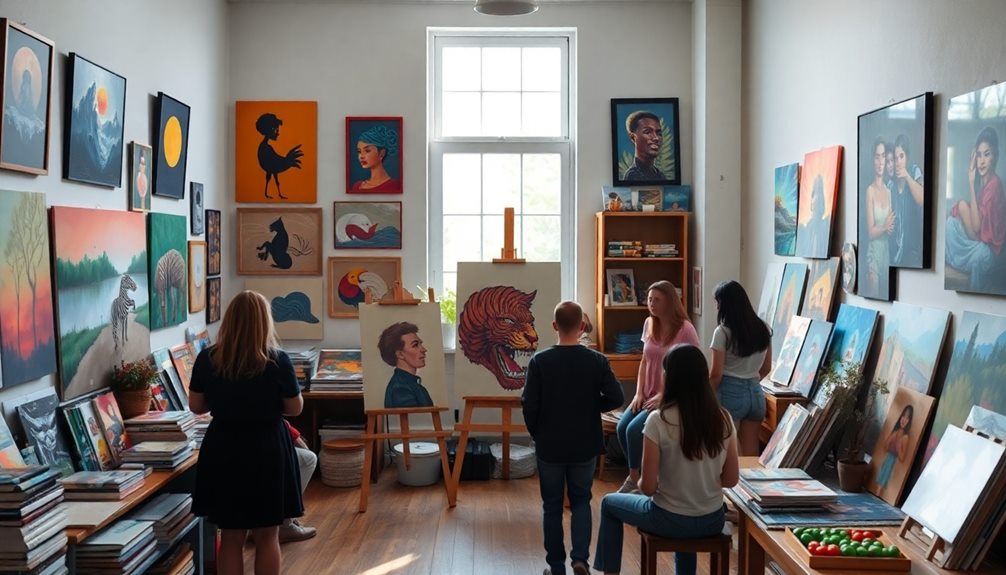
To truly appreciate art, you need to connect emotionally with it, and understanding the historical context plays a huge role in that.
By exploring different art movements, you can see how styles evolved and how artists responded to their world.
This knowledge transforms your viewing experience, making it more meaningful and enriching.
Emotional Responses to Art
Engaging with a painting can trigger emotions that resonate deeply with personal experiences and memories. When you step in front of a piece of art, you might find yourself feeling:
- Joy as you connect with vibrant colors.
- Sadness when recalling a past experience reflected in the artwork.
- Curiosity about the artist's intent and historical context.
These emotional responses to art are often shaped by your unique background and experiences, enhancing your connection to the piece.
As you explore various artworks, you'll discover that understanding the context, including the socio-political environment during its creation, can deepen your appreciation.
Teaching art appreciation isn't just about recognizing styles or techniques; it's about nurturing your emotional intelligence. Engaging with art allows you to reflect on your feelings and articulate your thoughts, which can enhance cognitive processing and retention.
The spectrum of emotions art evokes—from happiness to melancholy—invites you to reflect on your own life. Embracing these emotional responses can lead to a more profound understanding of art and its impact, making your journey into the art world both memorable and transformative.
Art Movements Overview
Throughout history, numerous art movements have shaped the way we perceive and create visual expressions. In your art appreciation class, you'll explore these pivotal movements, starting with the Renaissance, which flourished from the 14th to the 17th century. This era revived classical learning and introduced linear perspective, with masters like Leonardo da Vinci and Michelangelo leading the charge.
Next, you'll investigate the Baroque period, emerging in the late 16th century, known for its dramatic use of light and shadow and emotional intensity, highlighted by artists like Caravaggio and Rembrandt.
Moving into the late 19th century, Modernism challenged traditional norms, giving rise to Impressionism, Cubism, and Surrealism, with innovative figures such as Monet, Picasso, and Dali.
Post-World War II, Abstract Expressionism shifted focus to emotion through abstract forms, led by artists like Jackson Pollock and Mark Rothko.
Finally, you'll examine Contemporary art, which spans from the late 20th century to today, reflecting diverse styles and addressing social and political issues.
Understanding these movements is essential for grasping art history and enhancing your appreciation of visual culture.
Historical Movements Overview
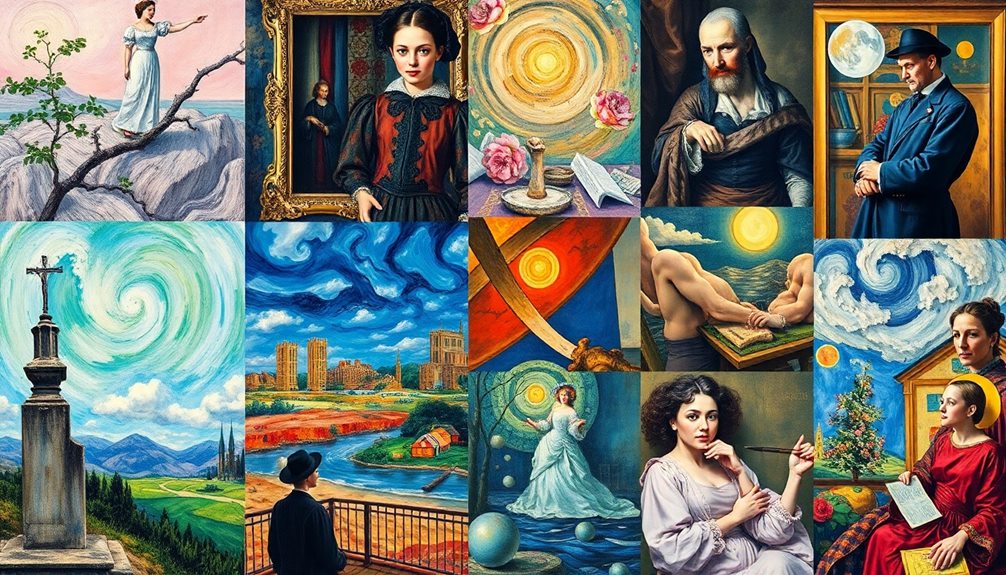
Art movements throughout history have shaped the way we perceive and appreciate creativity. Understanding these movements can enhance your art appreciation by highlighting key developments in artistic expression. Here are three major movements you should know:
- Renaissance (14th-17th century): This era is marked by a focus on humanism and realism, with masters like Da Vinci and Michelangelo revolutionizing perspective and anatomical accuracy.
- Impressionism (late 19th century): Breaking from tradition, artists like Monet and Renoir captured fleeting effects of light and color, challenging the elements of art by emphasizing perception over realism.
- Abstract Expressionism (mid-20th century): This movement shifted the focus to spontaneous creation and emotional expression, with figures like Jackson Pollock exploring painting as an act itself, paving the way for modern art.
Each of these movements not only reflects the artistic techniques of their time but also invites you to contemplate the evolving nature of creativity.
Practical Steps for Beginners
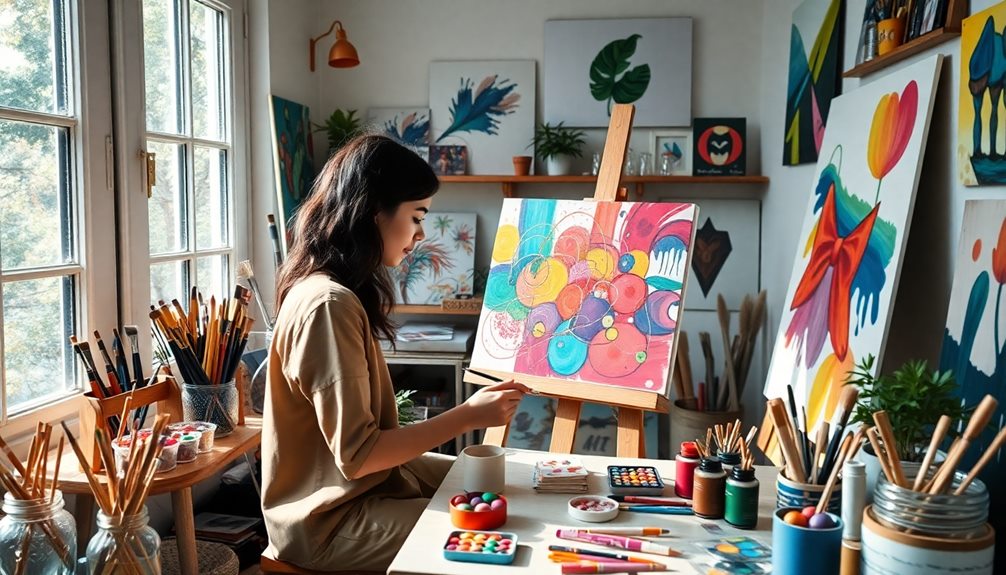
To truly appreciate art, you don't need to be an expert; you just need to immerse yourself in the experience. Start by visiting local galleries or museums. Engaging directly with artworks fosters a personal connection that enhances your art appreciation.
Exploring accessible resources like documentaries, art classes, and foundational books such as "The Story of Art" can provide essential context and knowledge about different art movements and styles.
Focusing on famous artworks or significant artists is a great way to build a solid foundation. This helps you recognize key contributions to art history and boosts your visual literacy.
Consider creating an art notebook where you can document your observations, reflections, and personal connections to the pieces you encounter. This practice encourages deeper engagement and retention of art concepts.
Lastly, participate in discussions about art, whether in informal settings or structured classes. This involvement develops your critical thinking and observational skills, which are essential for appreciating the nuances of art.
Building a Personal Art Map
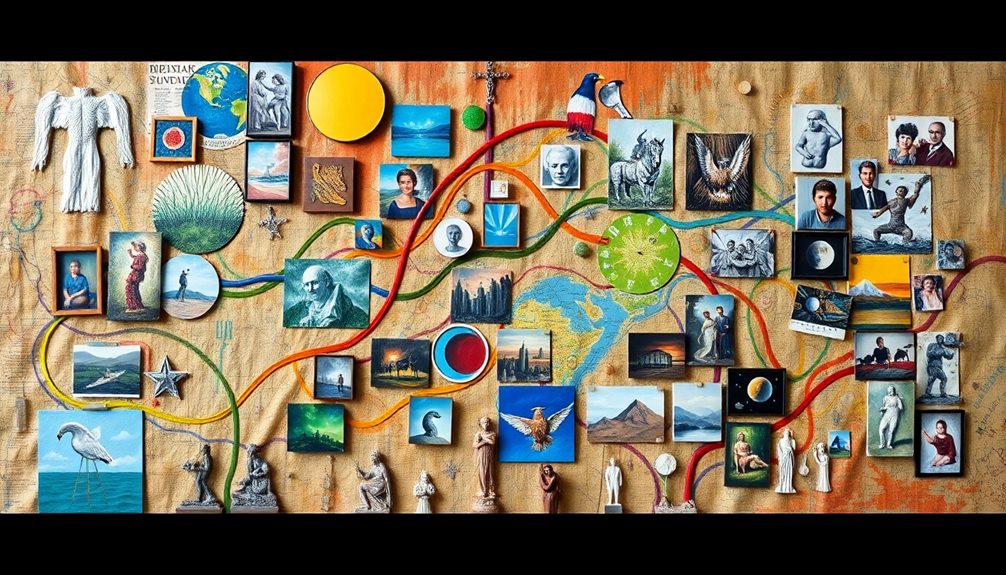
As you grow in your art appreciation journey, creating a personal art map can be a rewarding way to visualize your experiences and preferences.
This map connects various works of art and movements that resonate with you, highlighting your unique path through the art world.
Here are three steps to help you get started:
- Identify Key Artists and Styles: Familiarize yourself with artists whose work speaks to you. Understand their styles and contributions to art history.
- Reflect on Personal Experiences: Add your own reflections related to specific artworks. How do they make you feel? What memories do they evoke? This enhances your emotional connection to the art.
- Maintain Contextual Awareness: Keep a chronological understanding of art movements. This helps you appreciate the historical and cultural significance of each work of art.
Role of Curiosity and Engagement
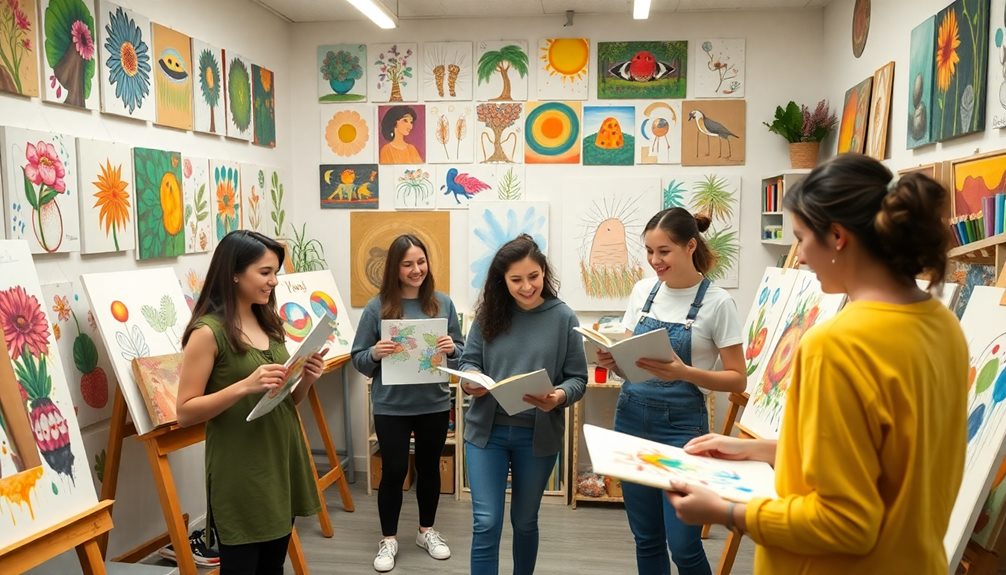
Curiosity is the spark that ignites your journey through the world of art, drawing you in to explore deeper meanings and contexts behind each piece. As you explore various artworks, your curiosity prompts you to ask questions about their meaning, context, and techniques, enhancing your overall appreciation.
Engaging with challenging pieces should evoke curiosity rather than frustration. This approach fosters deeper emotional connections and a more profound understanding of the artwork.
Utilizing diverse resources, like documentaries and art classes, can greatly boost your curiosity and engagement. These tools make the learning process enjoyable and enriching.
When you reflect on your art choices, you'll find that curiosity about your evolving tastes reveals insights into your values and preferences.
Hands-on experiences, such as creating your own art, stimulate both engagement and curiosity. By engaging in the artistic process, you appreciate the intricacies and efforts involved in artistic expression.
Teaching Strategies for Young Learners
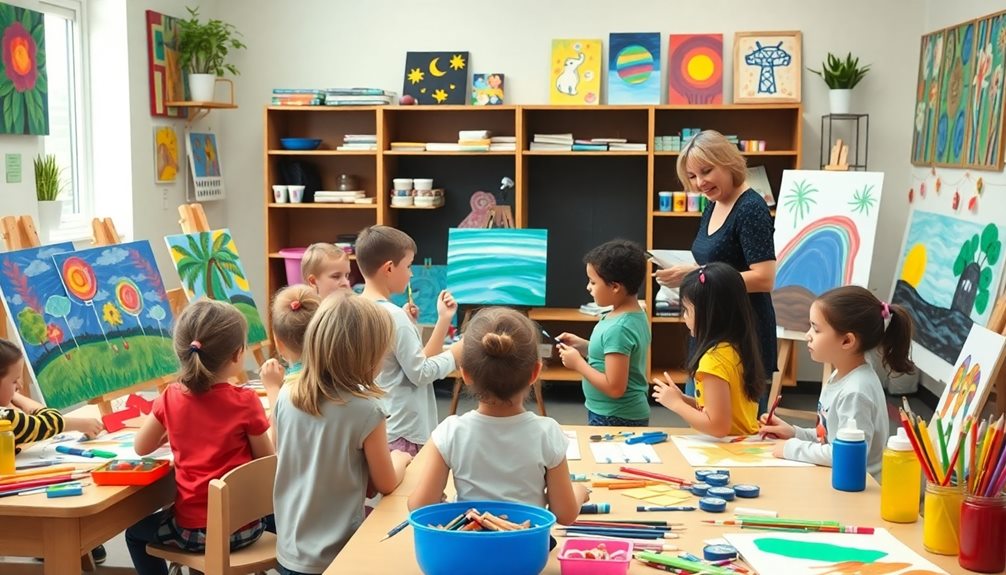
To engage young learners in art appreciation, you can use visual activities that spark their creativity and curiosity.
Simplifying artist introductions helps children connect with the art world, making it more relatable.
Engaging Visual Activities
Engaging young learners in art appreciation can really spark their creativity and understanding of visual elements. By incorporating engaging visual activities, you'll help them connect with art in meaningful ways. Here are three effective strategies to contemplate:
- Hands-on Activities: Have students trace lines and shapes found in artworks to grasp basic elements like line, shape, color, and texture. Additionally, incorporating Montessori toys that promote tactile experiences can enhance their understanding of these visual components.
- Storytelling Techniques: Use narratives behind the artwork to encourage kids to express their feelings and thoughts, making the experience more personal and relatable.
- Monthly Artist Focus: Dedicate time each month to explore a specific artist's work. This repeated exposure fosters deeper appreciation and encourages discussion.
Additionally, contemplate collaborative art projects that allow students to express their creativity while understanding cultural and historical contexts.
Incorporating engaging children's books, like "Claude Monet: Sunshine and Water Lilies," can further enhance visual literacy and introduce art in a relatable way.
Simplified Artist Introductions
Introducing young learners to artists doesn't have to be overwhelming; in fact, it can be a fun and enriching experience. To engage young minds, use simplified artist biographies that highlight key contributions and styles. Keep it concise and relevant, ensuring the information captivates their attention.
Start by connecting artist introductions to historical contexts, making the lessons relatable. This helps students understand the significance of influential art and its impact on the world. Instead of bombarding them with information about numerous artists, focus on a few significant figures each year. This approach allows for deeper understanding and better retention.
Incorporate visual aids and engaging stories about each artist to spark curiosity and excitement. Discuss the artist's works and their influence on art history, encouraging critical thinking and observational skills.
Ask questions that prompt discussion, fostering an interactive learning environment.
Interactive Art Exploration
Building on the excitement sparked by simplified artist introductions, interactive art exploration brings these concepts to life for young learners. This approach not only fosters art appreciation but also encourages creativity. Here are three key strategies to evaluate:
- Open-Ended Questions: Use prompts like "What do you see?" to stimulate observation and discussion. This encourages kids to articulate their thoughts and feelings about artworks.
- Hands-On Activities: Incorporate activities like tracing lines or shapes from art pieces. This helps children engage with basic elements of art such as line, shape, color, and texture.
- Literature Connections: Explore children's books that feature art and artists, like "Claude Monet: Sunshine and Water Lilies." This connects storytelling with visual appreciation, enhancing their understanding of historical and cultural contexts.
Additionally, implement interactive art projects where students can create their own artworks, reinforcing concepts learned during discussions.
Organize group discussions to share perspectives, promoting diverse interpretations and emotional connections to the art. Through these strategies, young learners won't only enjoy art but also deepen their understanding and appreciation for it.
Frequently Asked Questions
How to Appreciate Art for Beginners?
To appreciate art, start by exploring basic elements like line and color. Visit galleries, engage with artworks, and keep a notebook for observations. Use documentaries and books to deepen your understanding of various art movements.
What Are the 5 Steps in Art Appreciation?
To appreciate art, start by observing details, then describe what you see. Analyze techniques, interpret personal feelings, and finally, judge the artwork's impact. This process helps deepen your understanding and connection to the piece.
What Are the 4 Steps in Art Appreciation?
The four steps in art appreciation are observation, interpretation, evaluation, and emotional response. You closely examine the artwork, consider its meaning, assess its value, and reflect on your personal feelings to deepen your understanding.
What Is the First Step in Learning to Appreciate Art?
To appreciate art, start by immersing yourself in vibrant pieces that speak to you. Let their colors and forms stir your emotions, creating an intuitive connection that lays the groundwork for deeper exploration and understanding.
Conclusion
Incorporating art appreciation into your life can be like opening a window to a vibrant world of creativity and expression. By embracing the importance of understanding art's context and history, you'll enrich your personal journey and that of others. Remember, curiosity and engagement are your best tools. Whether you're teaching young learners or exploring solo, stay open-minded, and let the beauty of art inspire and guide you on this exciting adventure.
